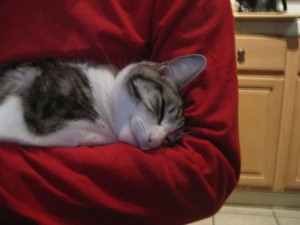A recent study, “Stable individual differences in vocalisation and motor activity during acute stress in the domestic cat,” from the Universidad Nacional Autónoma de México in Mexico City looked at whether or not adult cats were consistent in how much they vocalized and moved around in a repeated stressful situation. The stressful situation in question was being placed in a cat carrier three times (with one week between each testing session) to see how consistent each cat’s behavior was.

Photo by Hiroshi Shimizu
The behaviors in question were primarily the number of meows, but also how much movement each cat showed. Why meowing and activity? “Isolation calls” are commonly used to look at stress responses because animals tend to vocalize a lot when they are socially isolated. For example, kittens in a previous study by the same team at UNAM would meow and wiggle around a lot when separated from their mothers. The studies showed that the amount of meowing and activity was consistent within individuals across experimental sessions. What that means is that kittens who were more vocal and active compared to other kittens at one week of age were are also more vocal and active compared to other kittens at two and three weeks of age. From this the authors concluded that the responses to stress (vocalizing and being active) were stable behavioral responses that might reflect personality.
So that was in kittens who were very small (under a month old)…so what about adult cats? The study included 40 adult shelter cats, between 8 months and 11 years old. All of the cats were healthy, and had cat beds, toys, litter boxes, food, and water – all that good stuff – in the shelter. The researchers brought each cat into an unfamiliar testing room and then they placed the cat inside a standard cat carrier. They left the cat alone in the room in the carrier for 2 minutes. After 2 minutes they took the cat out of the carrier and put them back into their standard shelter housing. All of the trials were video recorded.
So what happened? First of all, there was an effect of age, such that older cats meowed less than younger cats. Further analyses revealed that during the first trial the cats were more active while being confined in the carrier, but as trials continued, the cats moved less. Perhaps they habituated to being in the carrier across the three sessions. Motor activity was not a stable measure because the cats were generally not very consistent in how active they were between weeks.

https://pixabay.com/photos/cat-carrier-animal-pet-feline-box-1815872/
The number of vocalizations did not vary statistically between trials — there was consistency within an individual cat as to how much they meowed on each trial compared to other cats. Cats who meowed more in the carrier in week one were more likely to more the second and third times they were in a carrier. This is very similar to what the same researchers found regarding kittens!
There was no relationship between meowing and activity. Motor activity and vocalization may reflect two different aspects of responding to stress; perhaps vocalizing is more related to fear or the separation, and activity may be more related to how an animal responds to a stressful situation — do they have a more active or passive style? Are they trying to get out or of the carrier, are they frustrated or maybe they are more fearful and trying to lay low for safety reasons?
The researchers concluded that activity is maybe not the most consistent way to measure stress but vocalisation seems to be a potentially repeatable marker of stress in non-human animals. This finding is similar to what has been revealed in cows, pigs, horses, kittens and now adult cats! Vocalizations are also often linked to negative emotional states. The researchers propose that measuring vocalization may be an efficient way to measure the emotional state of animals, keeping in mind that in cats both the presence and absence of vocalization can be related to high levels of stress…so context is probably very important!!
The researchers propose that in the future looking at vocalizations in relationship to other stress responses (e.g., heart rate variability, stress hormones) could help determine whether or not vocalization is a good measure of being stressed out. Because meowing was consistent across the trials, how talkative a cat is in different situations may be one aspect of “stable individual differences” — aka “purrsonality.”
References
Urrutia, A., Martínez-Byer, S., Szenczi, P., Hudson, R., & Bánszegi, O. (2019). Stable individual differences in vocalisation and motor activity during acute stress in the domestic cat. Behavioural Processes.
Hudson, R., Chacha, J., Bánszegi, O., Szenczi, P., & Rödel, H. G. (2017). Highly stable individual differences in the emission of separation calls during early development in the domestic cat. Developmental Psychobiology, 59(3), 367-374.



